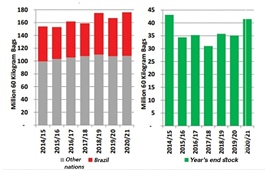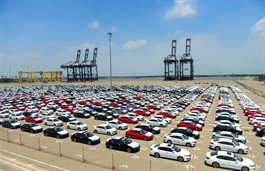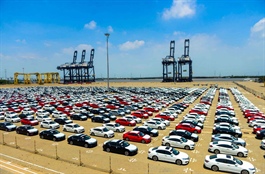EVFTA obligations can brew up coffee success
EVFTA obligations can brew up coffee success
Bolstered by the growing demand in the EU, Vietnam’s coffee industry has a major opportunity to capture a bigger market share on the European continent.

Even though much of Europe is struggling this year, Germany and Italy remain Vietnam’s largest coffee markets. Photo source: Freepik.com
|
Tran Van Thinh, owner of a coffee store in Berlin, expects that he could buy Vietnam’s speciality coffee products. “The locals like Vietnamese coffee but we still buy products from German and Italian roasters as they are more affordable,” Thinh said.
Thinh observed that Vietnamese brands have become more present in Europe in recent years. Vietnam is the second-largest coffee producer in the world after Brazil – however, most of what the nation exports to Europe is raw coffee, accounting for 95 per cent of all exports.
Despite the impact of the pandemic, the EU remains the largest export market for Vietnamese coffee, accounting for 60 per cent of total exports, of which 10-13 per cent are consumed in Germany alone, according to Nguyen Viet Vinh, general secretary of the Vietnam Coffee and Cocoa Association (Vicofa).
In the first half of 2020, Germany and Italy remained Vietnam’s largest consumer markets, according to the Ministry of Agriculture and Rural Development’s Department for Agricultural Products Processing and Market Development (DAPP). Last year, other EU nations also increased purchases of Vietnamese coffee, including a 53.7 per cent rise on-year from Poland to $23.5 million, and an on-year increase of 20.1 per cent from Belgium to $74.8 million.
EU market within reach
With the official implementation of the EU-Vietnam Free Trade Agreement (EVFTA), Vietnamese coffee exports to the EU are entitled to zero tariffs.
Vietnam boasts 38 geographical indicators (GI) used to identify product origins through the EVFTA, which includes Buon Ma Thuot coffee. This gives Vietnam’s coffee sector a competitive edge among roasters and consumers in Europe. Equally important, Vietnamese coffee products with GIs will not be hindered by barriers or compromised by other brands in the EU market. However, fresh standards must be met.
“The EU market does not have any technical barriers to Vietnam’s coffee imports”, said Le Thanh Hoa, deputy director of the DAPP. “But to increase coffee exports to the EU, we need to meet commodity import requirements, food safety standards, and comply with plant inspections and processing monitoring. If done right, businesses can increase their coffee exports to the EU.”
Europe has one of the highest average per-capita coffee consumption in the world at just above 5kg per person a year. Some Northern European countries like Finland, Ireland, and Norway even reach more than 8kg per person per year.
In 2019, the EU imported over 50 million bags from the wider world, and the bloc is expected to import an additional two million bags this year. This two million bags equal around 120,000 tonnes, about one month of Vietnam’s exports. It shows that the EU market is developing stably with vast potential for Vietnamese coffee.
Meanwhile, the current pandemic has also been creating several challenges to Vietnamese exporters in recent months. Phan Minh Thong, CEO of Phuc Sinh Corporation – which has been working with European partners for 20 years – said that business has been slowing down when most transactions were conducted online and export procedures became longer.
“It used to be two days but now we have to wait for one week. It is also difficult to send samples for testing and packaging for approval when import markets like Germany and Italy are closing borders. More customers are paying slower, and we often have to wait for 3-4 weeks for payment,” Thong said.
Blue Son La brand serves as a prime example for a success story of Vietnam’s first speciality coffee products to the EU. Thong was the trader behind Blue Son La, which is made from Arabica coffee beans. To further boost export of this brand, Phuc Sinh hopes that it will be certified for sustainable farming, guaranteeing the origin of this coffee.
Thong said that the EU market is brimming with opportunities for Vietnamese coffee, but it is essential to have financial capability, perseverance, and motivation to build brands like internationally successful coffee brands from elsewhere.
“Most Vietnamese companies just do some online marketing without developing their brands. However, if we don’t focus on the root of the problems, we will not create core value,” Thong added.
After its initial commercial success, Phuc Sinh developed a deep-processing factory with investment capital of VND100 billion ($4.38 million).
Adjusting to new habits
Though the ongoing pandemic has lowered the global coffee output, affecting the workforce of the industry, the crisis can be a catalyst for Vietnam to increase market share in the EU and reduce competitive pressure from Brazil – especially as the country is among the countries with the highest number of COVID-19 cases in the world and focuses less on production and processing.
Economist Nguyen Quang Binh said that Vietnam has an affordable source of Robusta coffee, and noted that buyers will never give up a good coffee supplier, but they have changed buying and selling habits. “Vietnam cannot continue to sell coffee in a street vendor fashion. It is critical to develop a real supply chain, thereby enhancing its added value in the region and using the benefits of the EVFTA in a sustainable way,” Binh said. “The Vicofa can learn from lessons from Brazil by helping coffee growers and commercial businesses, enabling them to take care of EU roasters and other markets in the world.”
In Vietnam, the Central Highlands province of Dak Lak, producing 90 per cent of Vietnam’s coffee output, is expanding coffee plantation areas but its export value is shrinking. In the 2018-2019 crop year, Dak Lak had around 200,000 hectares of coffee plantations with an output of nearly 480,000 tonnes. The province’s export value reached $343.3 million, with $314.5 million accounting for coffee beans and $28.8 million for instant coffee.
These figures were much lower than in the 2005-2006 crop year when the export value reached $382 million with only around 170,000ha, and an output of 292,000 tonnes.
Vietnam has developed 97 processing facilities, 160 roasting establishments, eight instant coffee units, and 11 blended coffee facilities across the country. However, many companies remain hesitant to invest in deep-processed coffee, which has become a major problem slowing down the spread of Vietnamese products in Europe, thereby missing out an opportunity as more attention is paid to these products by bars, coffee chains, and small roasters in Europe.
Vinh from the Vicofa said that specialty coffee is a niche segment which requires high quality and value. “Increasing the proportion of processed coffee will enhance the added value for Vietnamese coffee as well as make it less vulnerable to the price fluctuations in international futures markets, which are the main exchanges for coffee trade,” Vinh said.





















